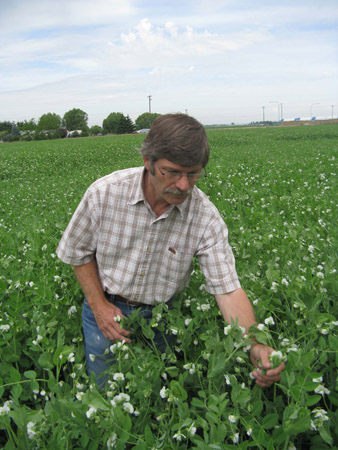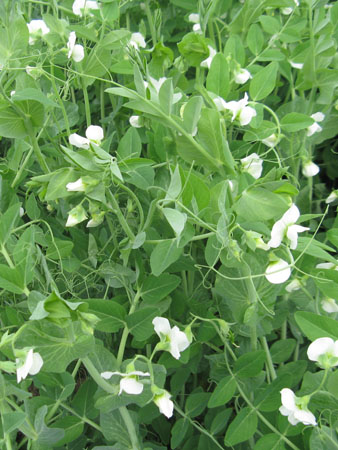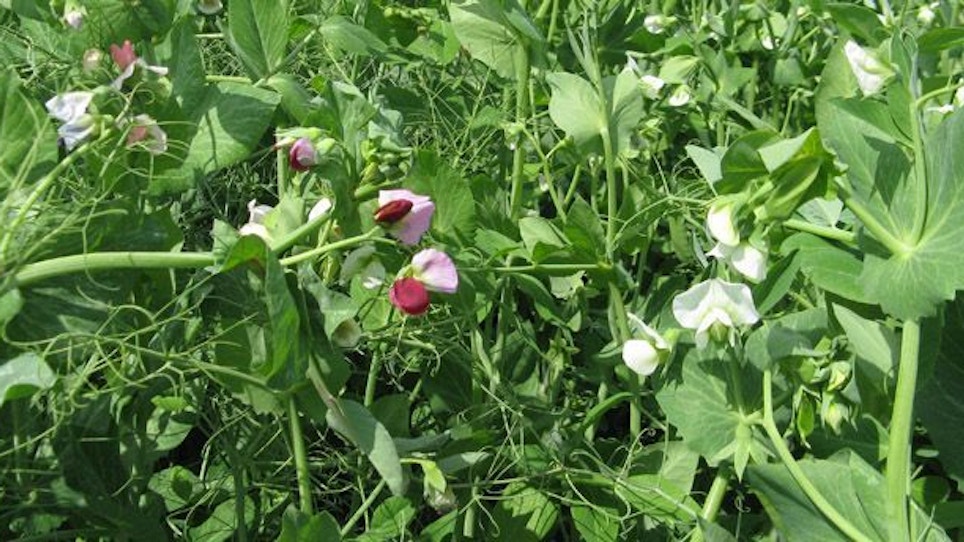That significance of that relationship between peas and deer is not lost on a growing number of savvy hunters who are now using the succulent annual as the primary buck attractant in their food plots. Mark Turner of Turner Seed Co, Winchester, Kentucky has watched the popularity of peas, as food plot fodder; grow, as the word on its effectiveness has spread across his state. "Even though we increase our orders every year we have trouble keeping everyone supplied," he says. "We've got customers who put in food plots every year who are crazy about these peas."
It doesn't take long for the word to spread says Turner. "These hunters talk to each other," he says. "If something works for one pretty soon they are all trying it."
Turner attributes much of the legume's new found popularity in Kentucky to the fact that the high demand seed he carries is not a conventional public variety like the purple flowered Austrian winter pea. Instead, his pea, a white flowered plant, is a proprietary variety with specific characteristics that make it particularly effective in food plots. "My customers say that the number one thing that puts these white flower peas ahead of the others is palatability," says Turner. "I have been told that the deer will walk straight through a stand of Austrians to get to these white flowered peas."

Mark Turner of Turner Seed Co, Winchester, Kentucky has watched the popularity of peas, as food plot fodder; grow, as the word on its effectiveness has spread across his state.
He notes that his sales reflect that sentiment. Since Turner began carrying the white flower pea the demand, for the Austrian winter pea that he also carries, has plummeted. "That is primarily due to the popularity of the white flower peas," he says. "Like the deer the hunters definitely have a preference for these new peas."
Two of the most commonly available white flower winter peas are Nutrigreen by Frost Master and Whistler. Turner distributes Nutrigreen.
There Are Peas and There Are Peas
So what makes white flowered peas more palatable than purple flowered peas? For plant breeders, who are involved in developing strains of peas specifically for livestock forage, the question is more than rhetorical. It is common knowledge, in that research community, that the reddish purple coloration in the flowers, stems and leaves of specific pea plants is due to the presence of anthocyanin, a pigment producing flavanoid that also contributes to that plant's bitterness. "The less anthocyanin a plant has the sweeter it is," explains pea breeder Kurt Braunwart, Progene Plant Research of Othello, Washington. "While the color itself doesn’t affect the flavor the chemical that creates the color does."
With this knowledge Braunwart has spent the last two decades selecting for light colored plants with little or no anthocyanin. Initially his work focused on producing high quality forage for the beef industry. "With cattle sweeter feed means higher intake, higher weight gain and more profits," he recalls.
But when his licensees and distributors, several of whom sold product to hunters and outfitters, began receiving glowing reports on the white flower's ability to attract the big bucks Braunwart began enhancing other plant qualities favorable to wildlife food plot establishment. Among these; now incorporated into his most recent pea releases are rapid establishment, vigorous regrowth and enhanced winter hardiness for stand longevity.
Proof in the Pudding
One of the first to recognize the potential of white flowered peas in game plots is Luther Wannamaker of L.B Wannamaker Seed and Wildlife Center located in St. Mathews, South Carolina. With a customer base that extends from the Carolinas through Florida Wannamacker has gained a well deserved reputation as one of the country's leading authorities on growing wildlife food plots. "Our Wildlife Center is located in the center of South Carolina where the deer density is very high," he says adding that his locale offers an ideal venue for evaluating new products. "We test everything to see what deer like the most."
For Wannamaker white flower peas were long overdue when he first starting carrying them in 2006. "For years I have been hearing complaints that the Austrian Winter Pea wasn't as attractive to deer as we had always hoped it would be," he says. "With this new pea we have no problems getting the deer to eat them."
 In addition Wannamaker sees the frost hardiness of the white flower winter pea he carries as another important attribute. "The spring peas we've tried are too easily killed by the cold," he says. "We need something that is tough enough to get us through the hunting seasons and into the late winter and early spring."
In addition Wannamaker sees the frost hardiness of the white flower winter pea he carries as another important attribute. "The spring peas we've tried are too easily killed by the cold," he says. "We need something that is tough enough to get us through the hunting seasons and into the late winter and early spring."
Charlie Smith of River City Seed, Little Rock, Arkansas is also impressed by the palatability and frost hardiness of the white flower winter pea. As both a vendor of wildlife seed and an avid deer hunter Smith is well acquainted with establishing viable food plots in his state. "I put out some significant food plots on my personal land and my lease," he says. "The number runs anywhere from 16 to 18 over the season."
Staying Power Required
Food plots are normally planted in August and September in Arkansas after the real hot weather has subsided. "Bow season begins in October, muzzle loader in November and the modern gun season runs through December with late bow season going on into the middle of February," says Smith. "Not only do we need peas that the deer like to eat but they also have to have some real staying power."
He notes that this winter was a real test of the white flower pea's ability to tolerate particularly harsh weather. "It was an exceptional winter with a lot of snow and ice and a whole lot of cold weather," he says. "And those peas are not only survived but are still growing and were about knee high as of April."
This is good news for Smith and others interested in maintaining a healthy deer population. He points out that while the primary goal is to keep food plots viable during hunting season there are some definite advantages to having plants survive through the winter and produce new growth in the spring. "These food plots can go a long way to helping the deer make it through the lean times before everything else greens up and the browse gets started," says Smith noting that deer are still probably munching on his white flower pea vines as we speak.
Photos by Agscribe Media






